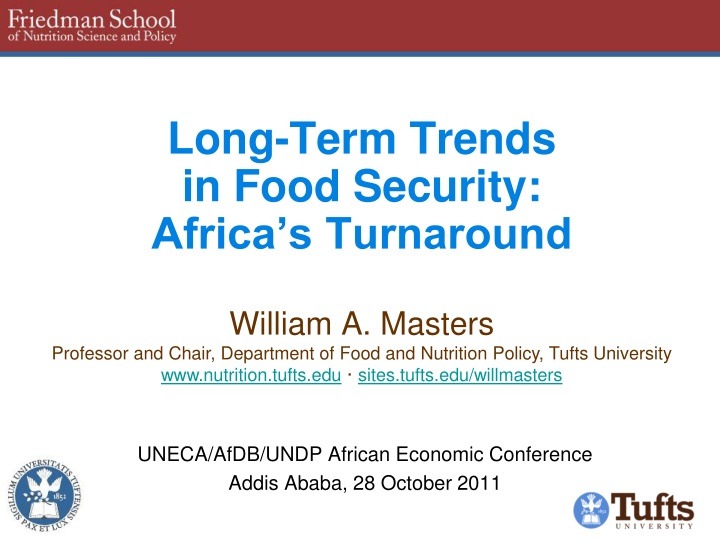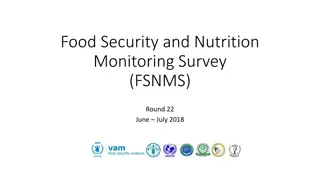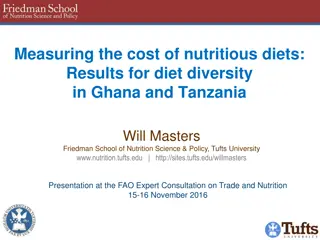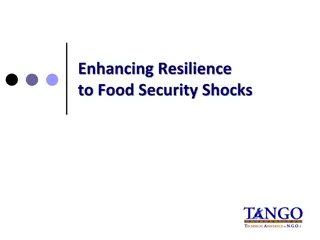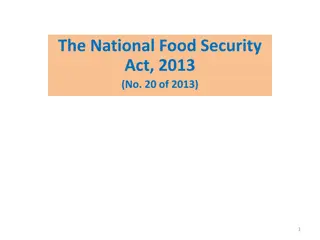Long-Term Trends in Food Security: Africa's Turnaround by William A. Masters
Africa has shown improvements in food security and poverty rates over the past decade, with limited data indicating positive signs. Undernutrition levels have also begun to improve in some African countries, though disparities still exist. Comparisons with Asia reveal differences in the severity of infant undernutrition. The region has seen progress over 20 years.
Uploaded on Nov 12, 2024 | 0 Views
Download Presentation

Please find below an Image/Link to download the presentation.
The content on the website is provided AS IS for your information and personal use only. It may not be sold, licensed, or shared on other websites without obtaining consent from the author.If you encounter any issues during the download, it is possible that the publisher has removed the file from their server.
You are allowed to download the files provided on this website for personal or commercial use, subject to the condition that they are used lawfully. All files are the property of their respective owners.
The content on the website is provided AS IS for your information and personal use only. It may not be sold, licensed, or shared on other websites without obtaining consent from the author.
E N D
Presentation Transcript
Long-Term Trends in Food Security: Africa s Turnaround William A. Masters Professor and Chair, Department of Food and Nutrition Policy, Tufts University www.nutrition.tufts.edu sites.tufts.edu/willmasters UNECA/AfDB/UNDP African Economic Conference Addis Ababa, 28 October 2011
Africas poverty rates rose only recently, and turned down over the past decade Source: Author s calculation from World Bank (2011), PovcalNet (http://iresearch.worldbank.org/PovcalNet/), updated 11 April 2011. Estimates are based on over 700 household surveys from more than 120 countries, and refer to per-capita expenditure at purchasing-power parity prices for 2005.
There are limited data and wide variation but many signs of improvement Source: Author s calculation from World Bank (2011), PovcalNet (http://iresearch.worldbank.org/PovcalNet/), updated 11 April 2011. Estimates are based on over 700 household surveys from more than 120 countries, and refer to per-capita expenditure at purchasing-power parity prices for 2005.
Undernutrition has also begun to improve in some African countries National trends in prevalence of underweight children (0-5 years) Selected countries with repeated national surveys Source: UN SCN. Sixth Report on the World Nutrition Situation. Released October 2010, at http://www.unscn.org.
...although undernutrition levels and trends still vary widely across Africa National trends in prevalence of underweight children (0-5 years) Selected countries with repeated national surveys Source: UN SCN. Sixth Report on the World Nutrition Situation. Released October 2010, at http://www.unscn.org.
Extreme under-nutrition occurs in infancy and is less bad in Africa than in Asia Mean weight-for-height z-scores in 54 countries, 1994-2007, by region (1-59 mo.) African infants are much less severely affected than Asia s The shortfall is worst at 3-24 months of age Source: CG Victora, M de Onis, PC Hallal, M Bl ssner and R Shrimpton, Worldwide timing of growth faltering: revisiting implications for interventions. Pediatrics, 125(3, Mar. 2010):e473-80.
In Asia, where undernutrition was worst, we ve seen >20 years of improvement National trends in prevalence of underweight children (0-5 years) Selected countries with repeated national surveys Source: UN SCN. Sixth Report on the World Nutrition Situation. Released October 2010, at http://www.unscn.org.
Africas green revolution is at least 20 years behind Asia s Source: Reprinted from W.A. Masters, Paying for Prosperity: How and Why to Invest in Agricultural Research and Development in Africa (2005), Journal of International Affairs, 58(2): 35-64.
The rise then fall in Africas child-survival baby boom is also 20 years behind Asia s Child and elderly dependency rates by region (0-15 and 65+), 1950-2030 Total dependency rates (ages 0-14 and 65+), 1950-2030 Africa had the world s most severe demographic burden (>45% ) now a demographic gift 50 45 40 SS Africa S Asia 35 SE Asia Rest of World 30 Source: Calculated from UN Population Projections, 2008 revision (March 2009), at http://esa.un.org/unpp.
The rise then fall in Africas rural population growth is also 20 years later Rural population growth rates by region, 1950-2030 Rural population growth (decade averages), 1950-2030 2.5% Over 2% annual growth for 30 years! 2.0% Under 1.3% annually, 1.5% and falling 1.0% SS Africa 0.5% S Asia 0.0% Below zero = more land/farmer -0.5% SE Asia -1.0% Rest of World -1.5% Source: Calculated from FAOStat (downloaded 17 March 2009). Rural population estimates and projections are based on UN Population Projections (2006 revision) and UN Urbanization Prospects (2001 revision).
An underlying cause of Africas impoverishment in the 1970s-1990s was a sharp fall in land area per farmer Land available per farm household (hectares) Reprinted from Robert Eastwood, Michael Lipton and Andrew Newell (2010), Farm Size , chapter 65 in Prabhu Pingali and Robert Evenson, eds., Handbook of Agricultural Economics, Volume 4, Pages 3323-3397. Elsevier.
Urbanization eventually employs all new workers so land per farmer can rise in Africa that won t happen until the 2050s Population by principal residence, 1950-2050 10 2.0 Billions Billions World (total) Sub-Saharan Africa 9 1.8 8 1.6 Total Total 7 1.4 Urban Urban 2010 6 1.2 Rural Rural 2010 5 1.0 4 0.8 3 0.6 2 0.4 1 0.2 0 0.0 2030 1950 1960 1970 1980 1990 2000 2010 2020 2040 2050 1950 1960 1970 1980 1990 2000 2010 2020 2030 2040 2050 Source: Calculated from UN World Urbanization Prospects, 2009 Revision , released April 2010 at http://esa.un.org/unpd/wup. Downloaded 7 Nov. 2010.
Africas green revolution has just begun USDA estimates of average cereal grain yields (mt/ha), 1960-2010 4.5 Rest-of-World 4.0 World 3.5 Southeast Asia 3.0 South Asia Sub-Saharan Africa 2.5 2.0 1.5 1.0 0.5 0.0 Source: Calculated from USDA , PS&D data (www.fas.usda.gov/psdonline), downloaded 7 Nov 2010. Results shown are each region s total production per harvested area in barley, corn, millet, mixed grains, oats, rice, rye, sorghum and wheat.
Foreign aid for agriculture has just begun to recover after being sharply cut in 1985-99 Source: Author's calculations from OECD (2011), Official Bilateral Commitments by Sector, updated 6 April 2011 (http://stats.oecd.org/qwids).
The wake-up of external aid for agriculture has been led by the Gates Foundation Top 15 donors foreign aid commitments to African agriculture, 2005-2008 Rank 2005 2006 2007 2008 IDA IDA United States IDA 300.72 538.88 463.07 867.01 1 AfDF AfDF IDA BMGF 152.04 226.81 399.16 2 367.23 Denmark France BMGF United States 114.98 141.80 391.77 323.58 3 United States EU Institutions France EU Institutions 102.30 114.79 342.42 181.73 4 IFAD BMGF AfDF Canada 80.72 235.65 155.20 5 99.03 Germany IFAD EU Institutions IFAD 66.88 87.50 186.30 129.49 6 Belgium United States IFAD France 66.43 84.78 122.76 95.13 7 EU Institutions Japan Japan Germany 65.75 66.12 73.36 87.25 8 Japan Sweden Korea Belgium 58.42 45.06 60.58 54.31 56.63 56.33 77.42 75.13 9 10 United Kingdom Canada Germany Belgium Germany Belgium Japan Ireland 43.48 53.48 53.20 41.81 11 Netherlands Norway Canada Norway 36.19 50.34 41.40 35.39 12 France United Kingdom Norway Italy 32.14 30.70 40.64 32.36 13 BMGF Ireland Denmark Denmark 22.56 31.46 29.17 14 24.80 Norway Netherlands Ireland Spain 20.80 19.01 24.79 19.31 15 Note: Exact amounts for BMGF have been obscured because methodology differs from that used by the DAC. Source: P. Pingali, G. Traxler and T. Nguyen (2011), Changing Trends in the Demand and Supply of Aid for Agriculture Development and the Quest for Coordination. Annual Meetings of the AAEA, July 24 26, 2011.
Many African governments are now focusing more on agriculture Slide is courtesy of Prabhu Pingali, Greg Traxler and Tuu-Van Nguyen (2011), Changing Trends in the Demand and Supply of Aid for Agriculture Development and the Quest for Coordination, at the AAEA, July 24 26, 2011.
Conclusions: Africa s Coming Turnaround in Agriculture and Food Security African poverty worsened from 1980 through 2000, but is now improving A major underlying cause is change in land available per farmer, driven down by rural population growth which is now slowing Appropriate new farm technologies are finally arriving, so crop yields, output and input use are now rising Investment in agriculture, food and nutrition security had shrunk to near zero, but is now being restored Investment in agriculture was key to cutting Asian poverty, then seen as no longer needed for Africa in the 1980s and 1990s; Africa is now poised for rapid uptake of new technologies, with many opportunities for sustained improvements
